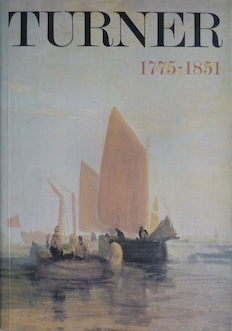|
18 XI 2024 |
4. Success at the Royal Academy 1801-12
084 - The Battle of Trafalgar, as seen from the Mizen Starboard Shrouds of the Victory | |

| ||
|
The Battle of Trafalgar took place on 31 October 1805 and the Victory, bearing Nelson's body, anchored off Sheerness on 22 December. Turner made a special trip to sketch the Victory as she entered the Medway and subsequently made a large number of detailed studies on board the ship in the 'Nelson' sketchbook (T.B.LXXXIX; see Nos. 95-7 and Wilkinson 1974, pp. 68-9). Another result of all this activity was the smaller oil painting of ‘The "Victory" beating up the Channel on its return from Trafalgar', probably shown in Turner's gallery the same year, subsequently in the Fawkes collection at Farnley Hall and now in the Mellon collection; here, however, he used his memories of the Needles (see No.19) for the background. Such journalist-like expeditions to sketch matters of topical interest were common in Turner's career: he went specially to Portsmouth in 1807 before painting Two of the Danish Ships which were seized at Copenhagen entering Portsmouth Harbour', exhibited unfinished at his gallery in 1808 (Tate Gallery 481), to the Low Countries in 1817 for 'The Field of Waterloo' exhibited at the R.A. in 1818 (Tate Gallery 500), to Edinburgh in 1822 to cover George IV's state visit (see No.308), and again down the Thames Estuary in 1838 before painting "The Fighting Temeraire' (National Gallery, London, 524). Perhaps because he had been so keen to show the picture as soon as possible after the event Turner seems to have felt the need to work on it further before exhibiting it again in 1808. According to the writer, probably John Landseer, of a long review in The Review of Publications of Art for 1808, ‘The picture appears more powerful both in respect of chiaro-scuro and colour than when we formerly saw it in Mr. Turner's gallery, and has evidently been since revised and very much improved by the author'. Describing the picture as ‘a British epic picture' the writer called it the first picture of the kind that has ever, to our knowledge, been exhibited'. 'Mr Turner . .. has detailed the death of his hero, while he has suggested the whole of a great naval victory, which we believe has never before been successfully accomplished, if it has been before attempted, in a single picture.' In fact there were precedents for the joint portrayal of a heroic death and a continuing battle in Benjamin West's 'Death of Wolfe' of I77I and John Singleton Copley's ‘Death of Major Peirson' of 1783 (Tate Gallery). In this painting Turner broke away completely from the seventeenth and eighteenth-century conventions of painting battles at sea. The only precedent for this close-up concentration on the details of the battle seems to have been John Singleton Copley's Siege of Gibraltar' of 1783 (Guildhall Art Gallery; a reduced size replica in the Tate Gallery). The treatment however owes more to P. J. de Loutherbourg, in such works as his 'Battle of the Nile' of 1800 (Tate Gallery). The disappearance of Turner's own 'Battle of the Nile', exhibited in 1799, is all the more maddening in that it might have shown how early Turner displayed his own personality in this genre. This work is also available as a carving. An image generated by an AI Machine Learning Model Property of the artist. | ||
